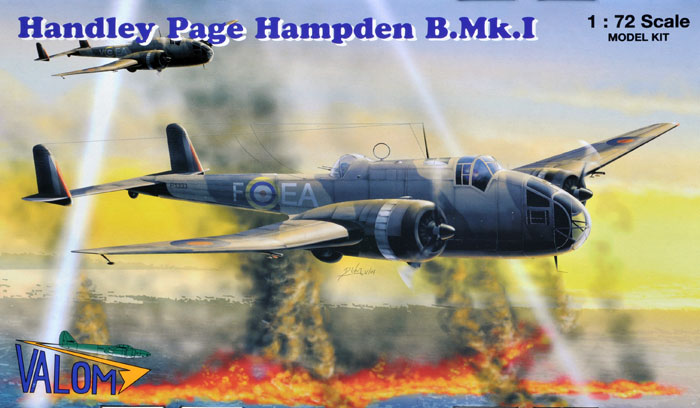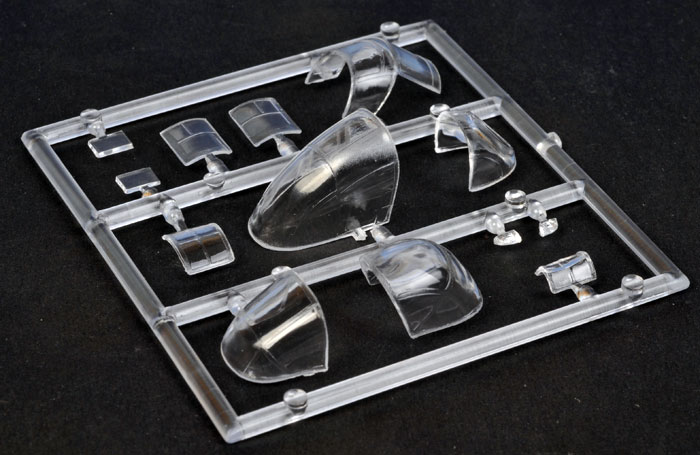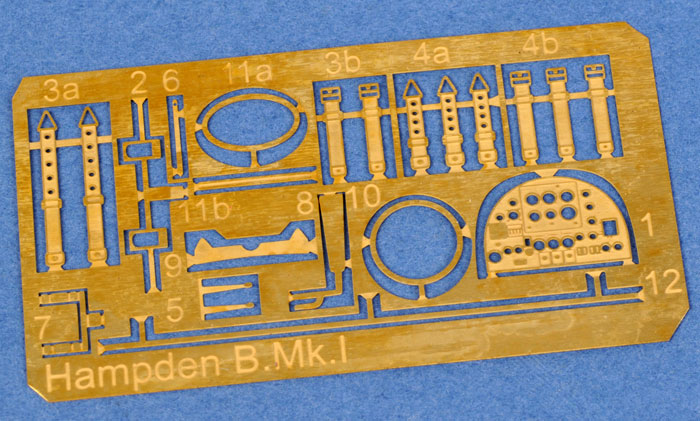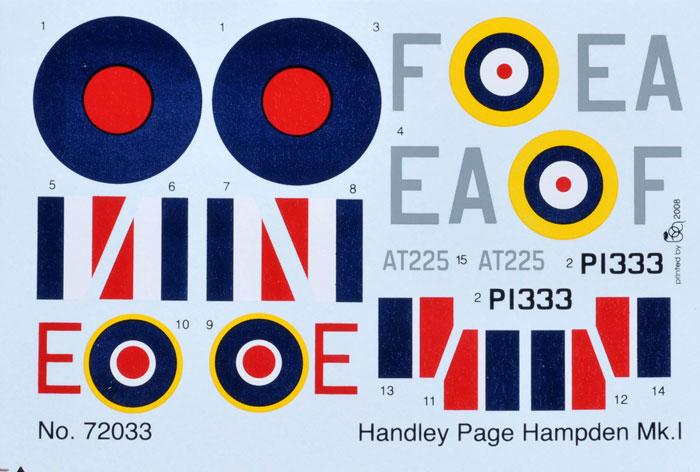|
H.P. Hampden B.Mk.I

Valom, 1/72 scale
S
u m m a r y |
| Catalogue Number: |
Valom 72033 H.P. Hampden B Mk.1 |
| Scale: |
1/72 |
| Contents and Media: |
79 parts of grey styrene arranged over two sprues, 1 sprue of transparencies containing 13 parts, 1 fret of photo-etch for 22 parts, an acetate film and decals for two subjects. |
| Price: |
GBP£27.50 available online from Hannants
AUD$45.00 online from NKR Models in Australia
will be available from Squadron |
| Review Type: |
FirstLook |
| Advantages: |
Cleanly moulded short run kit with engraved panel lines and control surface; Provides the basic essentials for an excellent model of the Hampden. Sooo long awaited, |
| Disadvantages: |
Butt-joins at major construction points, Transparencies a little thick. Modelling experience will be required |
| Conclusions: |
Some surprising shortcomings / omissions but generally a good kit that, with care and patience, deliver an excellent model of the Hampden |
Reviewed by Peter Mitchell

Valom's 1/72 scale Hampden B.Mk.I
will be available online from Squadron.com
The first three quarters of the 1930’s witnessed a dramatic change in aircraft design technologies. Many aircraft designed at the beginning of the decade that represented the cutting edge at the time, where virtually obsolete as soon or soon after they entered service only a few years later.
Such was the case for the Handley Page Hampden.
Designed to the same Air Ministry specification that also produced the Vickers Wellington, the Hampden was the last of the pre-war bombers to enter service within Bomber Command in the autumn of 1938.
For its time the Hampden was considered to be fast, manoeuvrable and capable of delivering an impressive war load over long ranges. The times were, however changing and the Hampden entered service around the same time as a new generation of fighter planes such as the Messerschmitt B f109.
Also known by the nick name “Flying Suitcase” or “Flying Tadpole”, the Hampden was characterised by a long, slim and deep fuselage, no more than three feet wide. This feature greatly restricted movement for the four crew members and prohibited the installation of any power turrets.
Relying on speed, manoeuvrability and a modest armament of light machine guns for their defence, the early daylight raids by Hampdens squadrons suffered heavily at the hands of Luftwaffe fighters just as its contemporary’s the Blenheim and Wellington did.
Bomber command switched to night bombing raids and for the first three years of the war the Hampden along with the Wellington and Whitley took the bombing war to the enemy.
As a new generation of larger bomber designs became available the Hampden was phased-out of service with Bomber Command, but this was not the end of their frontline service. When 97 and 207 Sqn encountered problems with the Avro Manchester, the Hampden- the aircraft it replaced, was called back into service until these problems were resolved.
The Hampden continued to serve on into 1943 as a torpedo bomber with Costal Command, with four squadrons being so equipped. Two of these units (144 and 455 Sqn) ferried their Hampdens to northern Russia for the role of convoy protection. These aircraft were later transferred to the Soviet Navy.
In all, some 1433 Hampdens were produced and approximately half of these (714) were lost on operations.
Many of the great names of Bomber Command, such as Guy Gibson served with Hampden squadrons and two of Bomber Commands Victoria Crosses were awarded to Hampden crews.
Long before this kit, Airfix produced the first and until recently, the only 1/72 injection moulded Hampden; that was way back in 1968 (before I was born). For its time it was excellent, one the great kits to come out of “the Golden Age of Airfix”.
Even today it stands up quite well, but it has some deficiencies that are more a symptom of the age than any real failing.
The four main difficulties that the Airfix kit presents are:
-
Rivets, lots of raised rivets!
-
Lack of interior... there was more in there than most kits of the day and there was the option of an open or closed bom bay with racks and bomb load but not much elsewhere. Airframe make a marvellous photo-etch detail set that solved this problem.
-
Poor engine detail, just a half engine front on a backing plate.
-
Thick transparencies... this was the thing that killed me. I can fix the above issues relatively easily and while Falcon/Squadron do make a vac-form replacement set, it is fiddley (for me at least) and a bit beyond my skill level.
So, here we are, some 40 years later and at last the modelling world has a brand new 1/72 injection moulded Hampden...... how does it compare?
Is it better than the Airfix kit?
Well... Yes...... but I’m not sure it’s 40 years better.
Please forgive me if what I’m about to write seems a bit picky and overly critical, but I (and many other modellers for that matter) have waited a long time for a new Hampden. So I had some “high” hopes and expectations.
The main components consist of seventy nine parts of grey styrene arranged over two sprues, the surface detail consists of engraved panel lines and is in many places festooned with engraved rivets.
I’m not sure how I feel about this feature; it is an improvement on the Airfix kit, however photos of Hampdens in service show that for the most part their skins were quite smooth and this detail appears a bit over-done and un-necessary. This may improve under a coat (or two) of primer or paint.
The fabric sections, such as the control surfaces are adequate but perhaps not as convincing as they could be.
This is a short run kit, consequently there are no locating pins and care will need to be taken when performing the construction of the major parts. The components of the tail section and the tail section joint to the fuselage are all butt joins, these will require some sort of pinning/tabs to ensure strength and the correct alignment. There are locating ridges for attaching the wings and this will greatly facilitate their attachment and alignment.
The trailing edges are thin and the props are nicely done, however sink marks in some of the parts are evident (D/F fairing, undercarriage legs, tail wheel and engine intakes for example).
The kit appears to have an accurate outline and compared to the Airfix kit , it follows the same outline, Valom got the wingtips right, (the Airfix ones are too rounded but correctable).
The transparencies are arranged on a single sprue of containing thirteen parts, these make up the canopies for the various crew stations, the wingtip lights and the leading edge landing light (the later needs to be boxed in). They are a little thick in places, but are largely free from distortion and I will have no hesitation using them. The modeller may wish to resort to the Falcon vac-form replacements (designed for the Airfix kit) for sections that were often seen open on Hampdens such as the pilots sliding canopy or the rear gunners clamshell. The skylights in the mid-upper fuselage have been forgotten and these will need to be drilled out and filled with a transparent medium, Krystal Klear perhaps.

The finer details for the kit are supplied as photo-etched parts. Twenty two of these are supplied on a modest but nicely detailed fret; this consist mainly of the crews seat belts, but also includes various aerials, pitot tube, cockpit controls, rudder pedals and a nicely rendered instrument panel (this is however minus the rather prominent central compass, an oversight the modeller needs to correct).

The kits interior detail is adequate, but will benefit from further detailing; the detail that is provided is largely confined to the nose and cockpit areas. This takes the form of side-wall framing and some instrumentation, cockpit floor and seats. The rear is largely free of detail, simply seats and a radio panel in the upper gun position.
The kit supplies a bomb bay which has a small amount of ceiling detail and little else. The bomb bay doors are moulded shut and it seems the bomb bay at this point is more for structural support that anything else.
To open this area up the modeller will have to perform some surgery and I have seen talk that Valom is producing a separate “enhancement” set for this area which will include two sets of new bomb bay doors (one set for the bomber version, the other for the torpedo version), a resin set of bombs, a torpedo and photo-etch details such as fins and bomb shackles.
This set will also includes the hedgehog flame dampener exhausts which are a surprising omission from the basic kit, as were the external wing mounted bomb shackles (something Airfix didn’t exclude from their kit).
The engines are very nicely rendered mouldings. The cowlings come in two parts and are in general very good, the cooling gills however seem to be a little too flush with the cowling itself. Photos of Hampdens usually show the gills to be partially open, and certainly raised. I therefore would have liked to have seen this feature somehow incorporated in the mouldings. The cowlings simply butt join to the wing and will require some care in their placement.
This section is designed in such a way that these mould will be easily applied to the Hereford version (i.e. the use of inline Dagger engines instead of the Pegasus radials).
The various intakes (such as the oil cooler) are moulded separately and as solid items, they will therefore require some hollowing out. The exhausts are nicely done (their ends are hollow) however as I have mentioned, only the short early sort versions are provided.
The undercarriage is well represented. The main wheel wells have a false roof and I suspect this is a compromise in accuracy (not that this will be easily seen). The modeller will have to scratch build the boxed in tail wheel well and is instructed in this process.
The kits instructions consist of nicely drawn construction steps and for the most part are well done. Some aspects are little confusing; such as the true location of intakes on the cowlings, so it is advised that references be consulted where possible. Some very helpful photos of the various crew stations and cockpit are provided and these will prove vital should the modeller wish to enhance the detail of these areas. The decal placement and painting instructions are provided as a full colour jacket to the above instruction sheet. These also reference paint colours for a wide range of widely available manufacturers.
The decals well printed and thin. The colours are for the most part correct and convincing, although I suspect that the roundel red is a little too bright. No stencils are provided and this is for me a little disappointing since Hamdens had a few, prominent stencils (such as W/T and trestle points) and Airfix managed to include these with later issues of their kit.

This kit offers two marking options:
- P1333. “EA-F”. 49 Sqn RAF, Scampton, 1940. This aircraft is featured on the box art and was the subject of a series of well known Air Ministry photos showing this aircraft being “bombed up”.
This aircraft is camouflaged in the style typical for a Hampden during this period in bomber command ie. Dark Earth/Dark Green over Black. The demarcation of the upper surface colours and the black is wavy and low along the fuselage, the upper colours wrapping under the wing and along the fuselage. Photos show that this aircraft had the early unshrouded exhaust, no external wing racks and had type A roundels under the wings with the white area greyed out (the later not included with the kit).
- AT225. ”E”. No. 1404 Meteorological Flight (later 517 Sqn) Coastal Command, 1943.
This aircraft is camouflaged in the style typical for Coastal Command ie. Dark Sea Grey over White. The demarcation of the upper surface colours and the White rides high up along the fuselage. This aircraft does not appear to be armed and should have late elongated-shrouded “hedgehog” type exhaust (again the later not included with the kit).
An up to date kit of the H.P. Hampden has been a long time coming and this kit was much anticipated.
This is a short run kit and as such I expect construction will present some challenges; however with care I would not expect it to be beyond the abilities anyone except the raw novice.
In spite of the above criticisms this is a good kit that a modeller with care and patience will be rewarded with an excellent model of the Hampden for their collection.
Highly Recommended with the above provisions.
Some very useful References...
-
Scale Models International September 1986 p435-439. 1/72 plans drawn by Peter Cooksley.
-
Hampden Squadrons in Focus. RedKite publications by Mark Postlethwaite
-
http://anonymous-generaltopics.blogspot.com/search/label/Hampden Some excellent photos of Hampdens in service
Thanks to Valom for this review
sample.
Review Text Copyright © 2008 by Peter Mitchell
Images Copyright © 2008 by Brett Green
Page Created 8 May, 2008
Last updated 8 May, 2008
Back to HyperScale Main Page
Back to Reviews Page |
